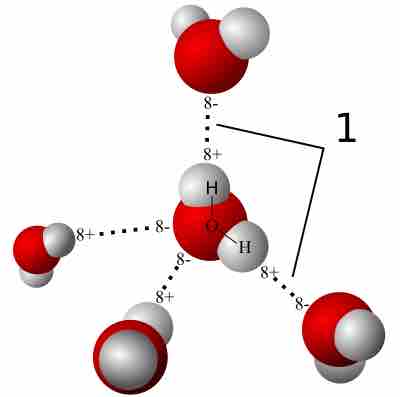In physiology, body water is the water content of the human body. It makes up a significant percentage of total body composition. Water is a necessary component to support life for many reasons. All cells in the human body are made mostly of water content in their cytoplasm. Water also provides a fluid environment for extracellular communication and molecular transport throughout the body. Water itself is also a key component of biochemical reactions involved in physiology, such as hydrolysis. Many organ systems depend on the physical properties of water, such as the surface tension of water in the alveoli of the lungs.

Water molecule
Model of hydrogen bonds (1) between molecules of water.
Overall Water Content
The total amount of water in a human of average weight (70 kilograms) is approximately 40 litres, averaging 57 percent of his total body weight. In a newborn infant, this may be as high as 79 percent of the body weight, but it progressively decreases from birth to old age, with most of the decrease occurring during the first 10 years of life. Also, obesity decreases the percentage of water in the body, sometimes to as low as 45 percent. The water in the body is distributed among various fluid compartments that are interspersed in the various cavities of the body through different tissue types. In diseased states where body water is affected, the fluid compartments that have changed can give clues to the nature of the problem.
Water Content Regulation and Measurement
Body water is regulated largely by the renal and neuro-endocrine systems. Water content regulation is one of the most important parts of homeostasis due to its influence on blood pressure and cardiac output. Much of this regulation is mediated by hormones, including anti-diuretic hormone (ADH), renin, angiotensin II, aldosterone and atrial natriuretic peptide (ANP). These hormones act as messengers between the kidneys and the hypothalamus, however the lungs, and heart are also involved in the secretion of some of these hormones, such as angiotensin converting enzyme and ANP respectively.
There are many clinical methods to determine body water. One way to get an uncertain estimate is by calculation based on body weight and urine output. Another way to measure body water is through dilution and equilibration using mass spectrometry, which measures water abundance in breath samples from individual. In bioelectrical impedance analysis, a person's hydration level is calculated from high precision measurements of the opposition to the flow of an electric current through body tissues. As water conducts electricity, a lower the hydration level will cause a greater amount of resistance to electrical flow through the body.